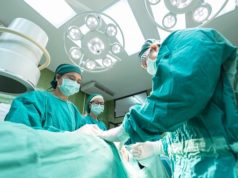 A new study, published in the European Spine Journal, suggests that a computer-aided method has the potential for automatic Cobb angle measurement and scoliosis diagnosis on chest X-rays. As the Cobb angle is involved in therapeutic decisions of scoliosis, the authors emphasise the “crucial” nature of the reliability and accuracy of this measurement.
A new study, published in the European Spine Journal, suggests that a computer-aided method has the potential for automatic Cobb angle measurement and scoliosis diagnosis on chest X-rays. As the Cobb angle is involved in therapeutic decisions of scoliosis, the authors emphasise the “crucial” nature of the reliability and accuracy of this measurement.
The investigators, Yaling Pan (Ruijin Hospital, Shanghai Jiao Tong University School of Medicine, Shanghai, China), Qiaoran Chen (Shenzhen Yi-Yuan Intelligence, Shenzhen, China), and colleagues, used two Mask R-CNN models as the core of a computer-aided method to separately detect and segment the spine and all vertebral bodies on chest X-rays, and the Cobb angle of the spinal curve was measured from the output of the MASK R-CNN model.
To evaluate the reliability and accuracy of the computer-aided method, Pan, Chen, and colleagues measured the Cobb angles on 248 chest X-rays from lung cancer screening using a computer-aided method, and two experienced radiologists used a manual method to separately measure Cobb angles on the aforementioned chest X-rays.
For manual measurement of the Cobb angle on chest X-rays, the intraclass correlation coefficients (ICC) of intra- and inter-observer reliability analysis was 0.941 and 0.887, respectively, . According to the authors, these results indicated that the computer-aided method had good reliability for Cobb angle measurement on chest X-rays.
In addition, using the mean value of Cobb angles in manual measurements above 10 degrees as a reference standard for scoliosis, the investigators found that the computer-aided method had good accuracy for scoliosis diagnosis on chest X-rays.
Pan and colleagues note that a few previous studies have been conducted for measuring the Cobb angle. For example, a contour and angle-function based methodology was proposed by Bonanni et al as an alternative to the classical vertebra endplate method for determining the Cobb angle. The method was less sensitive to noise and image artefacts because of dependence on the overall spine features.
They also mention that, recently, several studies have attempted to develop computer-aided methods using a deep learning technique. Wu et al, for instance, proposed a multi-view correlation network (MVC-Net) that allowed automatic assessment of the spinal curvature on anteroposterior and lateral X-ray views through joint multi-view input feature learning and explicit reinforcement of reciprocal relationships between the spinal landmark and Cobb angle. However, the MCV-Net might not be ideally suited for elderly patients with scoliosis, say the authors of this study, because the spinal landmark located in the four vertices of each vertebral body would be varied with the formation of marginal osteophytes.
Zhang et al developed a computer-aided method using a deep neural network that still requires manual intervention, such as assignment of vertebral patches, and was therefore “not reliable” to measure Cobb angle for in vivo radiographs, remark Pan and colleagues.
The investigators highlight a few limitations of the present study. Firstly, they note that the cobb angle measured by the computer-aided method was the maximum angle between the superior perpendicular of cranial vertebrae and inferior perpendicular of caudal vertebrae at the longitudinal central line of the vertebral body. When the spinal curves were ≥3, the computer-aided method might occasionally yield an incorrect result.
In addition, the whole spine radiographs were considered as the standard images for scoliosis assessment. The computer-aided method was needed to be trained and tested on the whole spine radiographs, and, finally, this retrospective study was a preliminary evaluation of the computer-aided method, and a prospective evaluation would be performed in further study.













